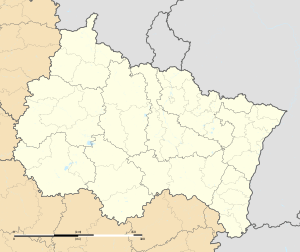Bar-lès-Buzancy
Bar-lès-Buzancy is a commune in the Ardennes department and Grand Est region of north-eastern France.[2]
Bar-lès-Buzancy | |
|---|---|
 The village centre and church | |
Location of Bar-lès-Buzancy 
| |
 Bar-lès-Buzancy  Bar-lès-Buzancy | |
| Coordinates: 49°26′02″N 4°56′32″E | |
| Country | France |
| Region | Grand Est |
| Department | Ardennes |
| Arrondissement | Vouziers |
| Canton | Vouziers |
| Intercommunality | Argonne Ardennaise |
| Government | |
| • Mayor (2014–2020) | Francis Potron |
| Area 1 | 9.4 km2 (3.6 sq mi) |
| Population (2017-01-01)[1] | 125 |
| • Density | 13/km2 (34/sq mi) |
| Time zone | UTC+01:00 (CET) |
| • Summer (DST) | UTC+02:00 (CEST) |
| INSEE/Postal code | 08049 /08240 |
| Elevation | 166–305 m (545–1,001 ft) (avg. 182 m or 597 ft) |
| 1 French Land Register data, which excludes lakes, ponds, glaciers > 1 km2 (0.386 sq mi or 247 acres) and river estuaries. | |
The commune has been awarded two flowers by the National Council of Towns and Villages in Bloom in the Competition of cities and villages in Bloom.[3] (Their sign says three but the official website says two).
Geography

Bar-lès-Buzancy is located some 20 km east by north-east of Vouziers and 25 km west by south-west of Stenay. Access to the commune is by the D947 road from Buzancy in the south-east which passes through the south of the commune and the village and continues west to Harricourt. The D6 goes north from the D947 forming the western border of the commune and continuing north to Sommauthe. The commune is mostly farmland with some forest in the north.[4][5]
The Ruisseau du Moulin rises in the north of the commune and forms part of the northern border before flowing south through the commune and the village and continuing south to join the Canal des Arches near Briquenay. La Hideuse stream forms the southern border of the commune as it flows south-west to join the Canal de Thenorgues.[4]
Toponymy
Bar comes from a Gallic word and perhaps even older (pre-Gallic) meaning "summit" or "height".
History
Bar-lès-Buzancy appears as Bar on the 1750 Cassini Map[6] and the same on the 1790 version.[7]
From 1828-1871 the commune was merged with Harricourt to form the commune of Bar-et-Harricourt. In October 1952 two Merovingian skeletons were discovered during the excavation phase of construction of a house.
Administration

| From | To | Name | Party | Position |
|---|---|---|---|---|
| 1965 | 2001 | Jean Potron | ||
| 2001 | 2008 | Michel Percebois | ||
| 2008 | 2020 | Francis Potron |
(Not all data is known)
Demography
In 2010 the commune had 118 inhabitants. The evolution of the number of inhabitants is known from the population censuses conducted in the commune since 1793. From the 21st century, a census of communes with fewer than 10,000 inhabitants is held every five years, unlike larger communes that have a sample survey every year.[Note 1]
| 1793 | 1800 | 1806 | 1821 | 1831 | 1836 | 1841 | 1846 | 1851 |
|---|---|---|---|---|---|---|---|---|
| 144 | 167 | 169 | 215 | 458 | 480 | 503 | 502 | 504 |
| 1856 | 1861 | 1866 | 1872 | 1876 | 1881 | 1886 | 1891 | 1896 |
|---|---|---|---|---|---|---|---|---|
| - | - | 432 | 184 | 189 | 185 | 182 | 178 | 174 |
| 1901 | 1906 | 1911 | 1921 | 1926 | 1931 | 1936 | 1946 | 1954 |
|---|---|---|---|---|---|---|---|---|
| 176 | 195 | 175 | 225 | 160 | 159 | 154 | 149 | 144 |
| 1962 | 1968 | 1975 | 1982 | 1990 | 1999 | 2006 | 2010 | - |
|---|---|---|---|---|---|---|---|---|
| 135 | 137 | 116 | 126 | 121 | 98 | 118 | - |


See also
Notes and references
Notes
- At the beginning of the 21st century, the methods of identification have been modified by Law No. 2002-276 of 27 February 2002 Archived 6 March 2016 at the Wayback Machine, the so-called "law of local democracy" and in particular Title V "census operations" allows, after a transitional period running from 2004 to 2008, the annual publication of the legal population of the different French administrative districts. For communes with a population greater than 10,000 inhabitants, a sample survey is conducted annually and the entire territory of these communes is taken into account at the end of the period of five years. The first "legal population" after 1999 under this new law came into force on 1 January 2009 and was based on the census of 2006.
References
- "Populations légales 2017". INSEE. Retrieved 6 January 2020.
- Bar-lès-Buzancy on Lion1906
- Competition for Towns and Villages in Bloom website Archived December 10, 2014, at the Wayback Machine (in French)
- Bar-lès-Buzancy on Google Maps
- Bar-lès-Buzancy on the Géoportail from National Geographic Institute (IGN) website (in French)
- Bar on the 1750 Cassini Map
- Bar on the 1790 Cassini Map
- List of Mayors of France (in French)
| Wikimedia Commons has media related to Bar-lès-Buzancy. |